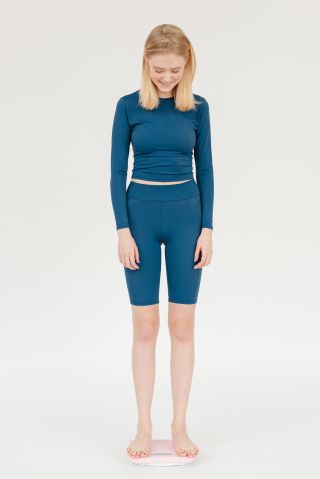Media
How to Judge an Instagram Workout
Researchers have developed a workout audit tool for social media consumers.
Posted August 17, 2023 Reviewed by Jessica Schrader
Key points
- Many Instagram "fitspiration" accounts contain unhealthy and even harmful information.
- It is often difficult to assess what accounts provide solid fitness advice.
- The Instagram Workout Audit Tool is a fast way to find credible internet workouts.

Many women, particularly 18- to 34-year-olds, seek fitness information and inspiration from various internet sources (Curtis & al, 2023; Ori, McHugh & Berry, 2022). Online workouts are accessible and popular and the number of fitness influencers posting to such platforms under the Instagram hashtag "Fitspiration" has increased (Ahrens & al., 2023). However, not all internet information is sound exercise advice. With the huge amount of available online workouts, how are we to choose good exercise programs?
It is not easy for the average consumer to know what is a solid, safe, and functional exercise program. In fact, many consumers are not able to effectively judge whether fitness information on the internet is accurate or believable. It is also easy to buy into persuasive messages that promise an improved appearance instead of improved fitness. If these messages are consistently visible, they are less often questioned and are taken as facts (Ori, McHugh & Berry, 2022). To help individual Instagram users assess more critically the online claims of fitness and exercise programs and advice, Curtis and colleagues (2023) have developed an audit tool for Instagram fitspiration accounts.
Unhealthy and Harmful Fitness Information on Instagram
Curtis and colleagues noted that fitspiration Instagram influencers can empower individual women to engage in healthy lifestyle choices. Nevertheless, a substantial amount of research reveals that such accounts actually contain unhealthy and even harmful information. For example, displaying only ultra-fit and thin bodies or emphasizing appearance instead of body functionality can lead to body image concerns and disordered eating (Fioravanti & al., 2022; Jerónimo & Carraça, 2022; Tiggemann & Zaccardo, 2015). Therefore, it is important to be able to identify which posts include potentially harmful or unhealthy content.

The Instagram Workout Audit Tool 1
To develop their criteria, the researchers selected 100 accounts from 40 individual fitspiration websites with the highest number of followers. The researchers developed four initial criteria to exclude posts with unhealthy content:
1. Nudity or inappropriate clothing (i.e., lingerie or bikini in a non-workout context such as modeling).
2. Sexualization (i.e., sexual posing such as an arching back) or objectification (i.e., images focused on one specific body part such as breasts, buttocks, or muscular abdominals).
3. Extreme body types (i.e., extreme thinness or muscularity).
4. Only four (out of 15 most recent posts) fitness-related posts (i.e., images or videos of an individual actively engaging in physical activity).
The account was not considered to contain credible fitness information if any items were marked with "yes." Of the accounts, 59 failed the assessment because they included one or more items from the criteria:
- 41 had fewer than four fitness-related posts.
- 26 included sexualization or objectification.
- 22 included nudity or inappropriate clothing.
- 15 displayed extreme body types.
- Three accounts failed on all four criteria, 13 failed on three, 10 failed on two, and 33 failed on one criterion.
After the assessment, it was clear that almost two-thirds of these popular accounts contained potentially harmful information and thus, were not credible fitness sites. Many posts included hyper-sexualization and unhealthy or unrealistic body shapes instead of fitness-related information. The researchers were alarmed by the continued focus on sexualization that objectifies women’s bodies, despite the increased amounts of posts by more women fitness influencers. They advised all users to take advantage of their audit tool to assess potentially unhealthy fitness and exercise information on Instagram and then make more informed choices regarding which accounts to follow.
This initial assessment effectively distinguished unhealthy fitness posts from healthy fitness posts. The researchers recommended it as an easy-to-use tool for individual women who are looking for functional, well-informed, and healthy exercise advice on Instagram.

The Instagram Workout Audit Tool 2
The researchers, however, wanted to take another look at the 41 accounts that passed the first analysis stage. They detailed that the account holders of these credible Fitspiration accounts were mainly women (59%), aged 25–34 (54%), Caucasian (62%), from the United States (79%), and half of them held a physical activity or physical health-related qualification (e.g., personal trainer, physiotherapy; 54%).
The researchers next analyzed the 15 most recent posts from these influencers to assess whether they contained:
1. Suspected image manipulation (i.e., altered body shape evident by blurred, disproportionate, or unnatural lines or shapes; filters that changed the lighting of the image were not considered image manipulation).
2. Promotion of "thinspiration" ideals (i.e., content that promotes excessive weight loss or disordered eating behaviours, statements with negative connotations to being overweight, or thin praise).
3. Dysfunctional quotations (i.e., quotations encouraging unhealthy or excessive attitudes towards the body, diet, or exercise);
(4) “Thinspo” hashtags (e.g., #thinspo, #thinspiration).
Again, the account was not considered to contain credible fitness information if any items were marked with "yes."
The more detailed analysis, nevertheless, did not help the researchers identify any more noncredible information, but can be useful for individual Instagram users who want to further check the information in postings that interest them.
A Fast Way to Assess Instagram Fitness Information
The suggested audit tool, the researchers wrote, is an easy and fast way to assess Instagram fitness information and as such, can help individual Instagram users to follow accounts with healthy fitness and exercise content. The tool also had what the researchers called high "inter-rater reliability." This means that when the researchers independently used the analysis tool, their assessments matched very closely.
The audit tool was developed to identify a potentially harmful focus on appearance that can lead to body image problems and eating disorder symptoms. However, we may need further advice on effective exercise, as not all workouts, even without an appearance orientation, are safe. After eliminating the "body shaping" fitness posts, we now require an additional tool to assess the functionality, safety, and usefulness of the exercises. This tool could help us assess, for example, if exercise modifications for different fitness and exercise experience levels were included. Or if there were instructions on the safe and effective performance of each exercise. Or if the exercises were anatomically correct. While we wait for the tool to assess the functionality of the workouts, we can begin choosing healthy exercise advice by eliminating appearance-focused internet accounts with the tool developed by Curtis and colleagues.
References
Ahrens, J,, Brennan, F,, Eaglesham, S,, Buelo, A., Laird, Y., Manner, J., Newman, E., & Sharpe, H. A. (2022). Longitudinal and comparative content analysis of Instagram fitness posts. International Journal of Environmental Research and Public Health, 19(11), 6845.
Curtis, R. G., Prichard, I., Gosse, G., Stankevicius, A., & Maher, C. A. (2023). Hashtag fitspiration: credibility screening and content analysis of Instagram fitness accounts. BMC Public Health, 23, 421 https://doi.org/10.1186/s12889-023-15232-7
Jerónimo, F., & Carraça, E. V. (2022). Effects of fitspiration content on body image: A systematic review. Eating and Weight Disorders-Studies on Anorexia, Bulimia and Obesity, 27(8), 3017-3035.
Fioravanti, G., Bocci Benucci, S., Ceragioli, G., & Casale, S. (2022). How the exposure to beauty ideals on social networking sites influences body image: A systematic review of experimental studies. Adolescent Research Review, 7(3), 419-458.
Ori, E. M., T. L. F. McHugh, T. L. F., & Berry, T. R. (2022). A qualitative exploration of exercise blog believability among emerging adult women. Qualitative Research in Sport, Exercise and Health, 14(4), 596-608, DOI: 10.1080/2159676X.2021.1954073
Tiggemann, M., & Zaccardo M. (2015), “Exercise to be fit, not skinny”: The effect of fitspiration imagery on women’s body image. Body Image, 15, 61–7.




